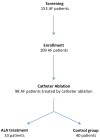Effects of Alpha Lipoic Acid on Multiple Cytokines and Biomarkers and Recurrence of Atrial Fibrillation Within 1 Year of Catheter Ablation
- PMID: 28258730
- PMCID: PMC5392151
- DOI: 10.1016/j.amjcard.2017.01.040
Effects of Alpha Lipoic Acid on Multiple Cytokines and Biomarkers and Recurrence of Atrial Fibrillation Within 1 Year of Catheter Ablation
Abstract
Catheter ablation (CA) is a procedure commonly used to restore sinus rhythm in patients with atrial fibrillation (AF). However, AF recurrence after CA remains a relevant clinical issue. We tested the effects of an oral antioxidant treatment (alpha lipoic acid [ALA]) on AF recurrence post-CA. Patients with paroxysmal AF have been enrolled in a randomized, prospective, double-blind, controlled placebo trial. After CA, patients have been randomly assigned to receive ALA oral supplementation (ALA group) or placebo (control group) and evaluated at baseline and after a 12-month follow-up: 73 patients completed the 12-month follow-up (ALA: 33 and control: 40). No significant difference has been detected between the 2 groups at baseline. Strikingly, 1 year after CA, ALA therapy significantly reduced serum markers of inflammation. However, there was no significant difference in AF recurrence events at follow-up comparing ALA with placebo group. Multivariate analysis revealed that the only independent prognostic risk factor for AF recurrence after CA is age. In conclusion, ALA therapy reduces serum levels of common markers of inflammation in ablated patients. Nevertheless, ALA does not prevent AF recurrence after an ablative treatment.
Copyright © 2017 Elsevier Inc. All rights reserved.
Conflict of interest statement
All Authors declare that they have no conflict of interest.
Figures
References
-
- Chugh SS, Havmoeller R, Narayanan K, Singh D, Rienstra M, Benjamin EJ, Gillum RF, Kim YH, McAnulty JH, Jr, Zheng ZJ, Forouzanfar MH, Naghavi M, Mensah GA, Ezzati M, Murray CJ. Worldwide epidemiology of atrial fibrillation: a Global Burden of Disease 2010 Study. Circulation. 2014;129:837–847. - PMC - PubMed
-
- Marfella R, Sasso FC, Siniscalchi M, Cirillo M, Paolisso P, Sardu C, Barbieri M, Rizzo MR, Mauro C, Paolisso G. Brief episodes of silent atrial fibrillation predict clinical vascular brain disease in type 2 diabetic patients. J Am Coll Cardiol. 2013;62:525–530. - PubMed
-
- January CT, Wann LS, Alpert JS, Calkins H, Cigarroa JE, Cleveland JC, Jr, Conti JB, Ellinor PT, Ezekowitz MD, Field ME, Murray KT, Sacco RL, Stevenson WG, Tchou PJ, Tracy CM, Yancy CW American College of Cardiology/American Heart Association Task Force on Practice G. 2014 AHA/ACC/HRS guideline for the management of patients with atrial fibrillation: a report of the American College of Cardiology/American Heart Association Task Force on Practice Guidelines and the Heart Rhythm Society. J Am Coll Cardiol. 2014;64:e1–76. - PubMed
-
- Kirchhof P, Benussi S, Kotecha D, Ahlsson A, Atar D, Casadei B, Castella M, Diener HC, Heidbuchel H, Hendriks J, Hindricks G, Manolis AS, Oldgren J, Popescu BA, Schotten U, Van Putte B, Vardas P Authors/Task Force M, Document R. 2016 ESC Guidelines for the management of atrial fibrillation developed in collaboration with EACTS: The Task Force for the management of atrial fibrillation of the European Society of Cardiology (ESC)Developed with the special contribution of the European Heart Rhythm Association (EHRA) of the ESCEndorsed by the European Stroke Organisation (ESO) Eur Heart J. 2016
Publication types
MeSH terms
Substances
Grants and funding
LinkOut - more resources
Full Text Sources
Other Literature Sources
Medical


